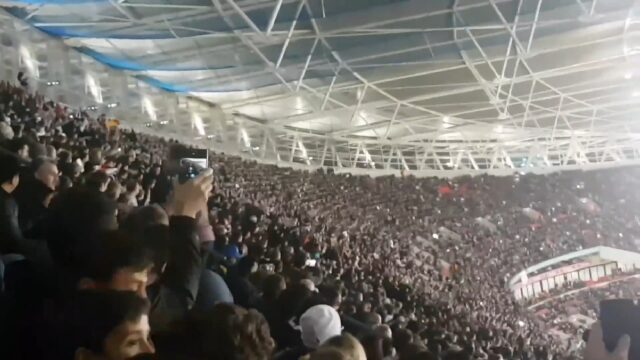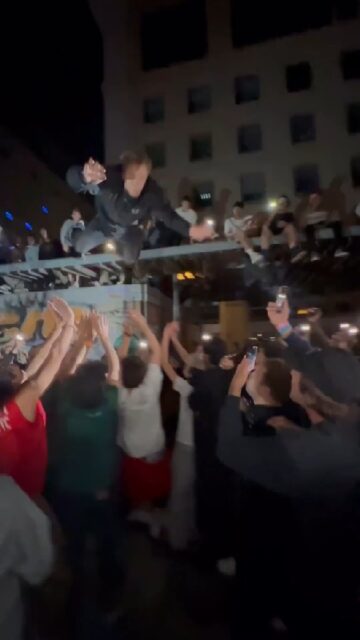Definition:
An “audience” is a group of people who gather to watch, listen to, or participate in an event, performance, or presentation.
Etymology:
The word “audience” comes from the Latin “audientia,” meaning “a hearing” or “listening.” It is derived from “audire,” which means “to hear.” This origin reflects the traditional role of the audience as listeners or observers.
Description:
Audiences can vary widely in size, composition, and context:
- Live Audiences: Gather in physical locations such as theaters, concert halls, sports arenas, or conference rooms to experience events in real-time.
- Virtual Audiences: Engage with content online through webinars, live streams, virtual meetings, and social media platforms.
- Reading Audiences: Consist of individuals who engage with written content, including books, articles, and digital publications.
- Broadcast Audiences: View or listen to content transmitted via television, radio, or online streaming services.
Herd Mentality:
Whenever there’s an audience, several herd mentality behaviors are common:
First of all, joining an audience to watch a show is an example of herd mentality behavior. Of course, there are times when a show is so good that one does not have a choice but to join a massive audience to witness it. However, people are generally doing a lot for very little. Examples of this include people who travel by plane or boat to reach another country just to watch a game. Cereal boxes and soda bottles constantly try to incentivize people to buy their products for a tiny chance to win a trip across the world to see a soccer game or a basketball game. Another example is how thousands of people show up to watch certain types of races, such as ski races, bike races, and marathons, where the audience travels far from home to sit in one spot all day and wait for the participants to pass by once.
Applause is a widespread form of showing appreciation or approval, while booing is a widely recognized way of expressing dissatisfaction or disapproval. When people see others clapping, they are likely to join in, even if they are unsure whether the performance truly merits applause. This is driven by the desire to fit in and not stand out as the only one not participating. Similarly, when a few individuals start booing, it can trigger others to do the same. The disapproval or negative sentiment becomes more intense and widespread as more people join in.
Laughter is a universal human behavior found in all cultures. People laugh in response to humor, surprise, joy, and social bonding. Audience laughter is common in settings such as comedy shows, theater performances, movies, and even in speeches and presentations where humor is used. Laughter is highly contagious. Hearing others laugh can trigger laughter in individuals, even if they did not initially find the situation funny. This is due to mirror neurons in the brain that respond to the sounds of laughter. People often look to others to gauge their own reactions. If an audience sees others laughing, they are more likely to join in, reinforcing the collective response.
A collective gasp is an emotional response that is quickly shared among the audience. When a shocking statement is made, the shared experience of surprise or shock can lead to a synchronized reaction. The presence of others reacting similarly can amplify an individual’s own emotional response. This means that a surprising statement may feel even more shocking when everyone around you reacts with a gasp. By provoking a collective gasp, the perceived impact of the statement is amplified. This can make the statement seem more significant or controversial than it actually is, swaying public perception and opinion. A collective gasp can be used to silence dissenting voices. If a speaker makes a controversial statement and the audience gasps collectively, it can create an atmosphere where opposing viewpoints feel pressured to stay silent to avoid similar reactions.
When people see others around them recording the event with their phones, they feel compelled to do the same. The act of recording becomes normalized, and individuals imitate the behavior of those around them to fit in. Instead of enjoying the firsthand experience of being at the show to witness it, sometimes the majority of people record the show on their phones to watch it later or post it on the internet, even though many others are doing the exact same thing, meaning it’s easy to find someone else’s recording. Click to watch a video clip.

At concerts, certain calm and emotional songs performed in the dark may trigger the audience to pick up their lighters or phones with their screens lit and wave them in synchronization with the rhythm of the song. Carrying the wave symbolism and symbolism of being chained to the rhythm.
Artists at concerts often engage the audience and enhance the live experience by commanding them to participate in various activities. Here are some common things artists say to command audience participation:
- “Put your hands in the air!”
- This gesture creates a visual display of unity and excitement, making the crowd feel connected and engaged.
- “Wave your hands side to side!”
- The synchronized movement of the audience creates a wave-like effect, enhancing the visual spectacle and fostering a sense of community.
- “Clap your hands!”
- Clapping along to the beat or in specific patterns amplifies the rhythm and involves the audience in the performance.
- “Sing it with me!” or “Everybody sing!”
- Encouraging the audience to sing along to familiar lyrics makes them feel like part of the performance, creating a powerful, collective vocal experience.
- “Repeat after me!”
- This call-and-response technique engages the audience and allows them to interact directly with the artist, enhancing their involvement.
- “Let me hear you say [phrase]!”
- Chanting unites the crowd in a shared vocal expression, building excitement and anticipation.
- “Everybody jump!”
- The physical act of jumping together creates a dynamic and energetic atmosphere, amplifying the overall energy of the event.
- “Let’s dance!” or “Dance with me!”
- Encouraging the audience to dance fosters a fun and lively environment, enhancing the enjoyment of the music.
- “Hold up your lights!” or “Let me see your phones!”
- The collective display of phone lights or lighters creates a visually stunning effect, often used during slower or emotional songs to create a serene and magical atmosphere.
- “When I say [word], you say [word]!”
- This technique fosters interaction and keeps the audience engaged, making them an active part of the performance.
Artists at concerts often show hand signs, and the audience tends to repeat them after seeing the artists do them, such as devil horns gesture, the peace gesture, and the love heart gesture. This is a prime example of herd mentality, as people tend to be completely ignorant of what these symbols actually represent.
“The wave,” also known as a “stadium wave” or “Mexican wave,” is a coordinated and visually striking activity often seen at large sports events. Usually, a small group of enthusiastic fans will start the wave. They stand up, raise their arms, and then sit down quickly. As adjacent sections of the crowd see the initiating group, they follow suit, standing and raising their arms before sitting down. This action creates a ripple effect that moves through the stadium. There is a video of two young boys starting a Mexican wave at a soccer stadium. Click to watch the video clip.

“Stage diving” is a performance practice often seen at concerts, particularly in genres like punk rock, heavy metal, and hardcore. It involves a performer or an audience member jumping or diving off the stage into the crowd, with the expectation that the crowd will catch and support them, preventing injury. The symbolism of stage diving is similar to that of the Illuminati pyramid, symbolizing the many lifting the few. There is a video of a man jumping from a platform, expecting the crowd to catch him. But the crowd is filled with people holding their phones up trying to record him, so no one puts in any real effort to catch him, and he lands straight on the ground. Click to watch the video clip.

A “mosh pit” is an area in front of the stage at a concert where audience members engage in energetic and often aggressive dancing, known as moshing. This activity is common in genres such as punk, metal, and hardcore music. The behavior involves pushing, shoving, and sometimes slamming into each other, creating a chaotic but often exhilarating environment. There are several forms of mosh pits. The most common form of moshing is pushing and shoving. There’s also “Wall of Death” where the crowd splits into two sides and then charges at each other on cue, usually initiated by the band, and “Circle Pit” where the crowd runs in a circular motion, creating a whirlpool effect. All forms of mosh pits are examples of herd mentality behavior. Even though people participating trust each other not to cause actual harm, there are almost always people getting badly hurt. There is a video of a mosh pit. Click to watch the video clip.

There is also a video of a circle pit in the audience of a God of Lamb concert in Lisboa (2019) where the crowd is running in circles. Click to watch the video clip.

“Hardcore dancing,” also known as “violence dance,” is a so-called style of dance associated with the hardcore punk and metalcore music scenes. Hardcore dancing is commonly seen at live performances, particularly in the mosh pit area, where fans engage in expressive physical movements that reflect the intensity of the music. Hardcore dancing involves a variety of intense movements, including windmills (spinning arms), spin kicks, floor punches, and two-stepping. These moves can appear chaotic and violent to the uninitiated. And of course people often get hurt. Click to watch a video clip.

Spectators often seek the thrill of being close to the action, and when a few individuals move closer, others tend to follow to get the same experience, assuming it is a good and safe spot without considering the actual risks. There is a video of spectators standing too close in front of a professional golfer, resulting in someone getting struck by the golf ball. Click to watch the video clip.

There is also a point-of-view video of hundreds of spectators standing dangerously close to a rally track, risking their lives. Click to watch the video clip.

There is also a video of a crowd of people being hit by a car at an intersection, which is something that is very common as people tend to believe these drivers are very precise, when they are most often just overconfident bad drivers. Click to watch the video clip.
